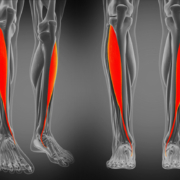Eliminating Pain
Chronic pain afflicts us all at some time. I’ve talked about my knee enough to write a book, but pain can be in many areas: lower back, shoulders, feet, hips, wrists, and deep muscle pain as might occur from fibromyalgia. Should you give the pain time to work itself out? No—that’s the worst thing you can do, because you may be setting yourself up for years of pain that could have been prevented.
Pain Pathways
Chronic pain may develop when pain pathways become established without intervention. While complicated in nature, what happens is that the series of biochemical reactions and different types of sensory neurons that let your brain know that something is painful get stuck in the “on” position. The original cause, whether from an injury, surgery, or a disease or condition, may have healed, but the nerve fibers are still sending pain signals. In order to affect changes in those pain pathways, you must take action.
Relieve the Pain
This seems obvious, but too many people refuse to do it. What I mean is that whether you’ve been prescribed pain medication or use over-the-counter medications, take them regularly. You don’t get hero badges for avoiding medications and staying in pain. You’re also not limited to medications.
There are many supplements that work for some people, including high-EPA omega-3 fish oil, glucosamine and chondroitin, tart cherry juice, turmeric, and others. If you’re going to take them, be consistent. We also now have CBD oil for internal use and creams and sprays for topical use. Some people find it works well for them, while for others they don’t work at all. How to know? Try each one.
If you can relieve the pain, you can return the area to normal functioning. This is especially true for muscles and joints. When you’re in pain, you compensate by changing the way move. That makes matters worse over the long haul. I’m not suggesting that you will be completely pain free, but if you’re able to move better, that will help you with the second part of pain management.
Rehabilitate
If you’ve had surgery on joints or soft tissue, you had to go through a physical therapy program to restore range of motion and function. The exercises that you were given were supposed to continue until you had a complete return to joint function. Most people get part way there and then stop. My father-in-law had surgery on both shoulders; he completely rehabbed his right shoulder after rotator cuff surgery, but he stopped short with his left. As a result, he could get close to putting his right arm fully extended overhead but got to only about ear level with his left.
Besides stretching to get back range of motion, you can also strengthen the muscles directly involved in the motion as well as those that provide stability to the joint. As just one example, the rotator cuff muscles do just that: they rotate the humerus. But the biceps, triceps, pectoralis major, and deltoid all provide stability to the shoulder. The best thing to do is to check with a physical therapist, most likely using an online video service these days, and get the exercises if you don’t know them. Then get to work.
The Bottom Line
In order to live your life fully, you must deal with chronic pain. The keys to pain management are to
- Reduce the pain
- Work on improving your movement of the area involved
- Work on strengthening the area and surrounding tissues
- If all else fails, consult a pain specialist.
That’s my goal for the next 60 days: to take a weakness and make it as strong as possible without causing any damage. Progress slowly and be methodical in the approach, and if that doesn’t work, get a referral to a pain clinic. Your life is too important to let pain rule you.
What are you prepared to do today?









